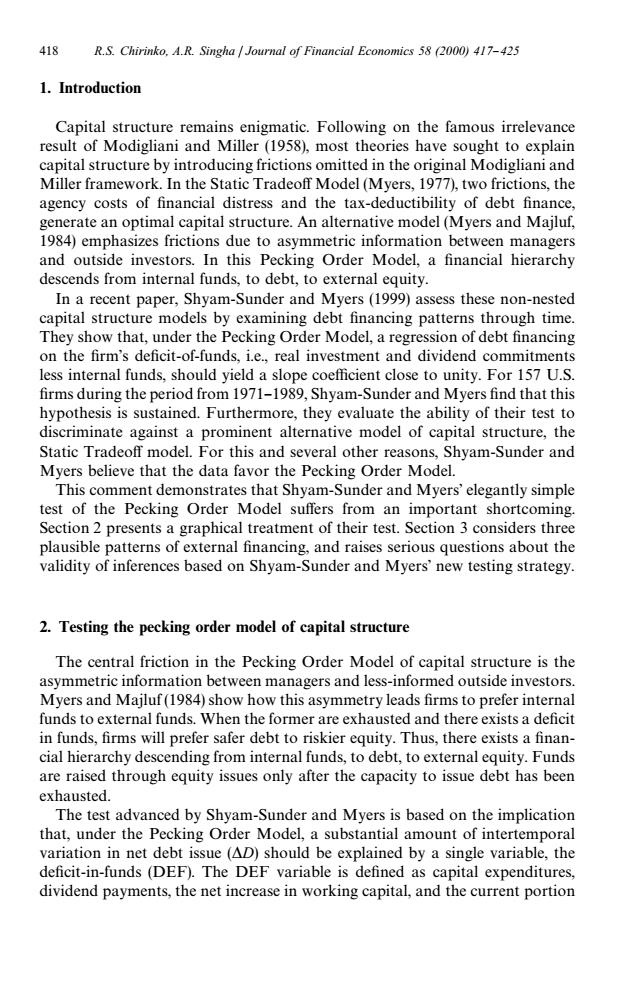正在加载图片...

418 R.S.Chirinko.A.R.Singha Journal of Financial Economics 58 (2000)417-425 1.Introduction Capital structure remains enigmatic.Following on the famous irrelevance result of Modigliani and Miller (1958),most theories have sought to explain capital structure by introducing frictions omitted in the original Modigliani and Miller framework.In the Static Tradeoff Model(Myers,1977),two frictions,the agency costs of financial distress and the tax-deductibility of debt finance, generate an optimal capital structure.An alternative model(Myers and Majluf, 1984)emphasizes frictions due to asymmetric information between managers and outside investors.In this Pecking Order Model,a financial hierarchy descends from internal funds,to debt,to external equity. In a recent paper,Shyam-Sunder and Myers(1999)assess these non-nested capital structure models by examining debt financing patterns through time. They show that,under the Pecking Order Model,a regression of debt financing on the firm's deficit-of-funds,i.e.,real investment and dividend commitments less internal funds,should yield a slope coefficient close to unity.For 157 U.S. firms during the period from 1971-1989,Shyam-Sunder and Myers find that this hypothesis is sustained.Furthermore,they evaluate the ability of their test to discriminate against a prominent alternative model of capital structure,the Static Tradeoff model.For this and several other reasons,Shyam-Sunder and Myers believe that the data favor the Pecking Order Model. This comment demonstrates that Shyam-Sunder and Myers'elegantly simple test of the Pecking Order Model suffers from an important shortcoming. Section 2 presents a graphical treatment of their test.Section 3 considers three plausible patterns of external financing,and raises serious questions about the validity of inferences based on Shyam-Sunder and Myers'new testing strategy. 2.Testing the pecking order model of capital structure The central friction in the Pecking Order Model of capital structure is the asymmetric information between managers and less-informed outside investors. Myers and Majluf(1984)show how this asymmetry leads firms to prefer internal funds to external funds.When the former are exhausted and there exists a deficit in funds,firms will prefer safer debt to riskier equity.Thus,there exists a finan- cial hierarchy descending from internal funds,to debt,to external equity.Funds are raised through equity issues only after the capacity to issue debt has been exhausted. The test advanced by Shyam-Sunder and Myers is based on the implication that,under the Pecking Order Model,a substantial amount of intertemporal variation in net debt issue (AD)should be explained by a single variable,the deficit-in-funds(DEF).The DEF variable is defined as capital expenditures, dividend payments,the net increase in working capital,and the current portion1. Introduction Capital structure remains enigmatic. Following on the famous irrelevance result of Modigliani and Miller (1958), most theories have sought to explain capital structure by introducing frictions omitted in the original Modigliani and Miller framework. In the Static Tradeo! Model (Myers, 1977), two frictions, the agency costs of "nancial distress and the tax-deductibility of debt "nance, generate an optimal capital structure. An alternative model (Myers and Majluf, 1984) emphasizes frictions due to asymmetric information between managers and outside investors. In this Pecking Order Model, a "nancial hierarchy descends from internal funds, to debt, to external equity. In a recent paper, Shyam-Sunder and Myers (1999) assess these non-nested capital structure models by examining debt "nancing patterns through time. They show that, under the Pecking Order Model, a regression of debt "nancing on the "rm's de"cit-of-funds, i.e., real investment and dividend commitments less internal funds, should yield a slope coe$cient close to unity. For 157 U.S. "rms during the period from 1971}1989, Shyam-Sunder and Myers "nd that this hypothesis is sustained. Furthermore, they evaluate the ability of their test to discriminate against a prominent alternative model of capital structure, the Static Tradeo! model. For this and several other reasons, Shyam-Sunder and Myers believe that the data favor the Pecking Order Model. This comment demonstrates that Shyam-Sunder and Myers' elegantly simple test of the Pecking Order Model su!ers from an important shortcoming. Section 2 presents a graphical treatment of their test. Section 3 considers three plausible patterns of external "nancing, and raises serious questions about the validity of inferences based on Shyam-Sunder and Myers' new testing strategy. 2. Testing the pecking order model of capital structure The central friction in the Pecking Order Model of capital structure is the asymmetric information between managers and less-informed outside investors. Myers and Majluf (1984) show how this asymmetry leads "rms to prefer internal funds to external funds. When the former are exhausted and there exists a de"cit in funds, "rms will prefer safer debt to riskier equity. Thus, there exists a "nancial hierarchy descending from internal funds, to debt, to external equity. Funds are raised through equity issues only after the capacity to issue debt has been exhausted. The test advanced by Shyam-Sunder and Myers is based on the implication that, under the Pecking Order Model, a substantial amount of intertemporal variation in net debt issue (*D) should be explained by a single variable, the de"cit-in-funds (DEF). The DEF variable is de"ned as capital expenditures, dividend payments, the net increase in working capital, and the current portion 418 R.S. Chirinko, A.R. Singha / Journal of Financial Economics 58 (2000) 417}425